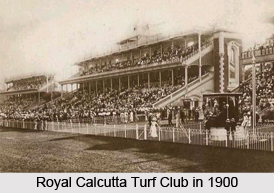 Modern History of Royal Calcutta Turf Club began with the introduction of Steeple chasing in the race course of Royal Calcutta Turf Club.
Modern History of Royal Calcutta Turf Club began with the introduction of Steeple chasing in the race course of Royal Calcutta Turf Club.
Modern History of Royal Calcutta Turf Club began with the establishment of race course in the open area near PG Hospital and the Research centre of Ronald Ross.
In the year 1915 the Tollygunge Race Course was closed and steeplechases were run at the Maidan course. In the early 1920s the RCTC became concerned about the lease of the course at the Maidan and looked around for an alternative. An obvious choice would be to expand the existing Tollygunj course, but once the possibility became known the price of adjacent land became exorbitant.
Race Course in Barrackpore
In 1922 a site to the north in Barrackpur, which included a race course, became available at an acceptable price. The RCTC decided to build a modern facility with new stands, stables and two courses, one round and one with six straight furlongs. The large grand stand would at first be partitioned between members and the public, and if the course was successful a separate members-only grand stand would be built. The railway agreed to provide a spur line to the course that could carry both horses and spectators. The new facility was inaugurated on 27th January 1928.
Grand Nationals and the Race Course
Grand Nationals was continued to be run at the Maidan course until 1929, when the Grand National was transferred to Lahore, where it was held until 1938. In the period before World War II (1939–1945) the club looked to Australia for guidance rather than to England. Thus the Australian Harvey Roulston was hired as an administrator, the Australian "Gray" gate was used in place of English starting gates, Australian jockeys such as Edgar Britt moved to Calcutta to ride for Sayajirao Gaekwad III, the Maharaja of Baroda State and Australian horses were imported.
Methods of Detecting Drugs In 1930
The methods of detecting drugs such as Benzedrine from urine or blood samples became available in the 1930s. The rules of the Turf Club were updated to insist that these test be conducted meticulously to detect cheating, years before such tests were introduced by the English Jockey Club. Despite the fact that the Barrackpur course was technically superior to the Maidan course in many ways, it did not attract the public and consistently lost money. Races were held until 1941, when the army requisitioned it during World War II (1939–1945). After the war the course was rehabilitated, and races were run in 1947 and 1948. After that, the Barrackpore course was closed. In 1954 it was sold to the government in an arrangement that included renewal of the lease of the Maidan course.
Uday Chand Mahtab and the Race Course in 1947
Sir Uday Chand Mahtab became a Steward in 1947. In 1955 he was elected as Senior Steward, a position he held for twenty seven years. During his tenure, in the early 1950s the South India Turf Club was split off from the Royal Calcutta Turf Club to oversee racing at Bengaluru, Chennai (Madras), Hyderabad, Mysore District and Ooty. The South India Turf Club in turn divided into separate authorities based on Madras, Bangalore and Hyderabad. In the 1970s these clubs and the original Calcutta and Bombay clubs joined in a loose association of Indian turf authorities.
Royal Calcutta Turf Club in Independent India
In February 1961, Queen Elizabeth II and Prince Philip visited the course and presented the trophy to the winner. The attendance by the elite at the races was an important social event even in the 1960s, where the women would wear their most glamorous clothes. In 1971 Geoffrey Moorhouse placed the Royal Calcutta Turf Club in the first rank of clubs in the city, along with the Bengal Club, the Tollygunge Club and the Calcutta Club.
Related Articles
Capital Cities of India
Kolkata
History of Kolkata
Kolkata, Indian City, West Bengal
Culture of Kolkata
Birla Planetarium, Kolkata
Economy of Kolkata
West Bengal, Indian State
British Monuments in Kolkata
Monuments in Kolkata, West Bengal Monuments
British Monuments in India
Monuments of West Bengal
Architectural Developments of Calcutta during British Rule
Early British Architectural Design in India
British Military Architecture in India
Art and Architecture during British Rule in India
History of Indian Telecommunications
Impact of British Rule in India
Fort William, Kolkata
Battle of Plassey
Sports in Kolkata



















